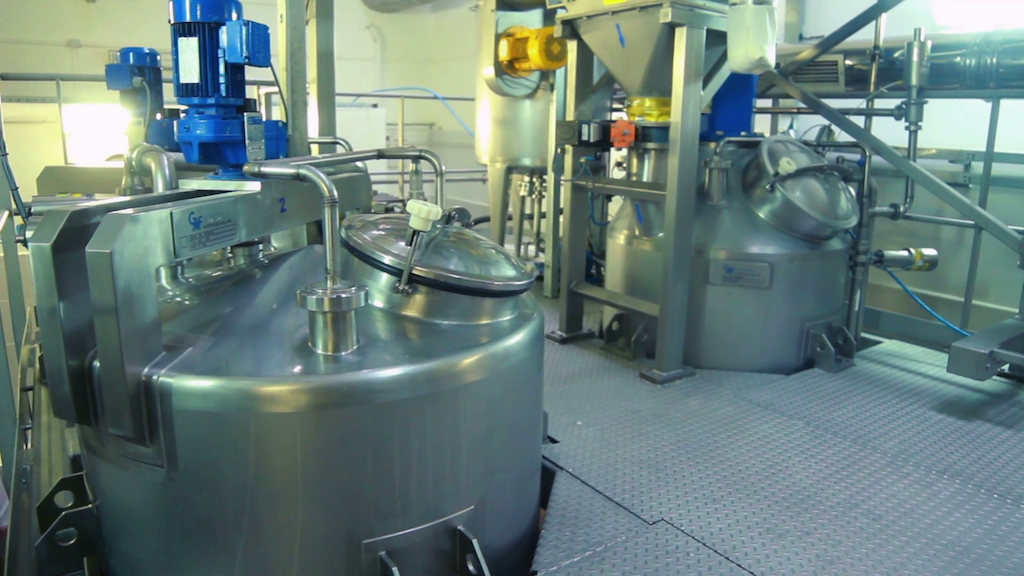Executive Summary
In this case study, we detail how BeChained, an AI-driven optimization platform, enhanced the energy efficiency and operational performance of two parallel-connected water pumps with capacities of 45 kW and 40 kW. These pumps serve a water distribution system comprising two tanks, which in turn supply more than 20 end users. BeChained achieved a significant 18.7% increase in energy efficiency, while maintaining system constraints for pressure and flow within a tight tolerance range of +5%/-5% to ensure product quality and adherence to customer specifications.
This optimization was achieved by adjusting the rotational speeds (RPM) of the electric motors based on real-time operational data, ensuring that flow and pressure remain within the required thresholds. This use case illustrates the effectiveness of the BeChained AI platform through pressure and flow regulation diagrams and provides a detailed comparison of electricity consumption before and after optimization, along with rotation speed variations over a 24-hour period.
Problem Statement
Water pumping systems are notoriously energy-intensive, and inefficient operations can result in significant energy waste. In this scenario, a company operates two water pumps (45 kW and 40 kW) that supply water to two tanks. These tanks then serve more than 20 customers who require precise flow rates and pressure to maintain the quality of the products they manufacture.
The pumps must operate continuously over a 24-hour period, while the flow and pressure need to be maintained within a specific range. Flow and pressure deviations can affect the quality of the end product, causing customer dissatisfaction and financial losses. Additionally, the company seeks to reduce energy costs and improve the sustainability of its operations.
The primary objectives are:
- Guarantee flow and pressure within a strict range of +5%/-5% of recommended values (constraint).
- Maximize energy efficiency and minimize electricity consumption (goal).
- Balance the workload between the two pumps, ensuring optimal operation (operational target).
- Maintain product quality by ensuring the correct pressure and flow delivery (quality target).
BeChained Solution Overview
BeChained’s AI-powered optimization algorithm was implemented to control and adjust the RPM of the two water pumps in real-time. The platform collects data on pressure, flow rate, and energy consumption, and uses these inputs to determine the ideal RPM for both pumps, minimizing energy use while ensuring that the system’s constraints are met.
Key Features of BeChained’s Optimization:
- Real-time Monitoring & Adjustments: BeChained continuously monitors flow and pressure and dynamically adjusts the RPMs of both pumps based on operational demand.
- Adaptive Workload Distribution: The AI algorithm balances the workload between the 45kW and 40kW pumps to ensure both operate at their highest efficiency, reducing unnecessary energy consumption.
- Predictive Control: By analyzing historical data and usage patterns, BeChained predicts peak and off-peak demand periods, adjusting pump operations accordingly.
- Tight Control Over System Constraints: Flow and pressure are strictly maintained within a +5%/-5% range, ensuring no compromise in product quality.
System Overview and Baseline Operations
Initial Setup
- Pump 1: 45 kW
- Pump 2: 40 kW
- Parallel configuration: Pumps are connected to two tanks that feed into a network supplying water to 20+ end users.
- Flow and Pressure Range: Specified by the customer, with flow and pressure needing to remain within +5%/-5% of the ideal values.
Baseline Performance:
- Pumps operated at a constant RPM, consuming significant energy even during off-peak periods.
- No real-time adjustments were made to balance operational efficiency with demand fluctuations.
- High electricity consumption due to over-pumping during low-demand periods.
Optimized Operations by BeChained
After the deployment of BeChained, the following operational improvements were made:
- Variable Pump Speed: The RPMs of both pumps were adjusted dynamically based on real-time flow and pressure data, maintaining optimal conditions for water delivery.
- Energy Efficiency Improvement: Energy consumption was reduced by 18.7%, primarily by adjusting pump speed during periods of lower demand while still meeting flow and pressure requirements.
Results
1. Energy Consumption: Baseline vs. Optimized
The energy consumption curve before and after optimization is shown below:
- Baseline: The pumps operated at constant RPM throughout the 24-hour period, leading to high energy consumption, especially during off-peak hours.
- Optimized: The pumps’ RPMs were adjusted dynamically based on real-time data, reducing power consumption significantly during low-demand periods.
Electricity Consumption Graph:
2. Flow and Pressure Regulation
BeChained successfully optimized the flow and pressure within the customer-specified range of +5%/-5%, ensuring product quality while minimizing energy waste.
Pressure and Flow Regulation Graphs:
- Baseline Flow/Pressure: Shows irregularities in flow and pressure due to constant RPM operation.
- Optimized Flow/Pressure: Flow and pressure remained stable, with minor fluctuations within the acceptable range as the AI adjusted RPMs to respond to demand changes.
Flow and Pressure Graph:
3. Rotational Speed Variation (RPM): Baseline vs. Optimized
During baseline operations, the pumps operated at a constant RPM. After BeChained was introduced, the RPM varied according to demand, minimizing unnecessary power consumption while ensuring system stability.
RPM Variation Graph:
- Baseline RPM: Constant operation without adaptation to demand fluctuations.
- Optimized RPM: Dynamically adjusted RPM with reduced power consumption during low-demand periods.
RPM Variation Graph:
Conclusion
By utilizing BeChained’s AI-driven optimization, the water pumping system demonstrated a significant 18.7% reduction in energy consumption, while maintaining stringent flow and pressure requirements. This case study highlights how advanced AI can not only reduce operational costs but also ensure optimal product quality by maintaining critical system constraints.
Key Benefits of BeChained AI:
- Energy Efficiency: 18.7% reduction in energy consumption.
- Cost Savings: Reduced operational costs by optimizing electricity usage.
- System Performance: Maintained flow and pressure within customer-specified limits.
- Sustainability: Enhanced sustainability through lower energy consumption and optimized resource use.
BeChained’s AI optimization proved to be an effective solution for improving the operational efficiency of water pump systems, offering tangible benefits in terms of energy savings, cost reduction, and enhanced product quality.
Figures and Graphs Placeholder:
- Electricity Consumption Graph (Baseline vs. Optimized)

2. Flow and Pressure Regulation Diagrams

3. RPM Variation Graph (Baseline vs. Optimized)




